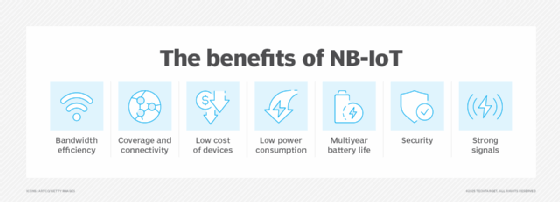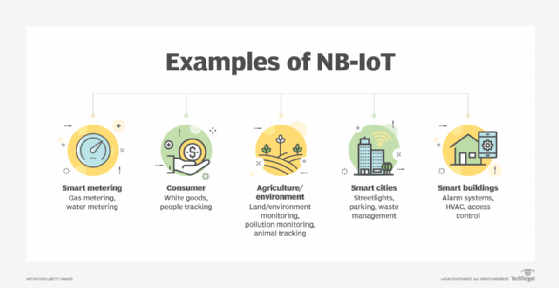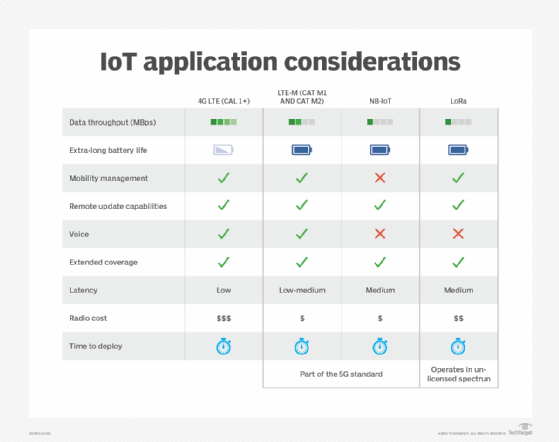What is narrowband IoT (NB-IoT)?
Narrowband IoT (NB-IoT) is a wireless internet of things (IoT) standard that uses low-power wide area network (LPWAN) technology. It was developed by the 3rd Generation Partnership Project (3GPP) for connecting IoT devices to established mobile networks. NB-IoT is one of the three main 3GPP LPWAN standards.
NB-IoT enables small amounts of infrequent two-way data transmissions between devices and a network, making it ideal for a wide range of devices and services that are low-bandwidth and that have long-life use cases. The NB-IoT communication standard lets IoT devices operate via carrier networks, either within an existing Global System for Mobile Communications (GSM) carrier wave, in an unused guard band between Long-Term Evolution (LTE) channels or independently.
One of the goals of NB-IoT is to boost the coverage extension beyond what existing cellular technologies offer. To do that, NB-IoT offers transmission repetitions and different bandwidth allocation configurations in uplink transmission.
NB-IoT can enable a broad range of new IoT devices and services. It reduces the power consumption of connected devices while increasing system capacity and bandwidth efficiency, particularly in locations that are not easily covered by traditional cellular technologies. NB-IoT-connected devices can have a battery life of more than 10 years for many use cases.
How does NB-IoT work?
NB-IoT is a data transmission standard designed to enable devices to operate in mobile carrier networks. It uses low-bandwidth signals to communicate within existing LTE and GSM technologies. The NB-IoT standard uses a small radio band of 180 kilohertz (kHz), specifically designed to support IoT use cases.
Specially designed devices and sensors are also used as basic components in NB-IoT systems. These devices collect information from their surroundings and transmit it to NB-IoT base stations or transmission nodes. Individual base stations are connected to an IoT gateway and IoT cloud application servers for centralized monitoring and data analysis.
NB-IoT employs a new physical layer with signals and channels to meet the requirements of extended coverage in rural areas and deep indoors while enabling low device complexity. The underlying technology is much less complex than that of GSM/General Packet Radio Services modules.
Supported by all major mobile equipment, chipset and module manufacturers, NB-IoT can exist along with second-generation wireless technology (2G), 3G, 4G, Long-Term Evolution-M (LTE-M) and 5G mobile networks.
What are the benefits of NB-IoT?
NB-IoT offers the following benefits:
- Bandwidth efficiency. NB-IoT is designed with bandwidth efficiency in mind. It uses a small portion of the spectrum, meaning multiple NB-IoT networks can coexist in the same area without any interference.
- Coverage and connectivity. NB-IoT can help support massive numbers of devices by establishing NB-IoT networks that can connect billions of nodes. Designed for extended coverage indoors, the devices' lower complexity provides long-range connectivity and communication.
- Low cost of devices. Because it's easier to create devices with lower complexity, the devices cost significantly less.
- Low power consumption. NB-IoT does not need to run a heavy operating system, such as Linux, or do a lot of signal processing, making it more power-efficient compared to other cellular technologies.
- Multiyear battery life. The enhanced power consumption capability enables NB-IoT to support devices with multiyear battery lives.
- Security. NB-IoT is secured using methods such as data encryption, secure authentication and signaling protection
- Strong signals. NB-IoT signal strengths are typically strong, designed to penetrate multiple layers of brick.

What are the challenges of NB-IoT?
There are still a few barriers to using NB-IoT, however, including the following:
- High latency. NB-IoT typically has high amounts of latency, making it less than ideal for any application that requires fast response times.
- Lack of redundancy. NB-IoT networks typically have limited backup options if coverage is lost or the network experiences an outage. If a network outage happens unexpectedly, for example, NB-IoT device connections will be interrupted.
- Limited data transmission. Voice or video transmission is not an option because NB-IoT can only transmit less than a kilobyte of data per day, which is about equal to a text message. The NB-IoT data upload rate is around 20 kilobits per second (Kbps) -- low compared to competing technologies. Its bandwidth is about 200 KHz.
- Limited device mobility. NB-IoT devices remain connected within a finite environment and only to one network operator. This could mean limitations for uses such as wearables that leave specific perimeters. If a person with a wearable device, for example, enters another country, the device might not work if the operator does not have a local presence.
- Limited large data transfers. NB-IoT has a slower data rate, so large quantities of data cannot be transferred quickly.
- Limited support for roaming. Roaming enables LTE-M and NB-IoT users to connect to their IoT devices across countries and mobile networks. However, the network must be supported in each country through which a user plans to connect.
Examples of NB-IoT applications
NB-IoT can be used for the following applications:
- Energy savings. Sensors can be used to save on devices that are often active, such as using automatic light-dimming motion sensors connected to an NB-IoT system in an office building.
- Healthcare. In healthcare, NB-IoT can be useful for remote patient monitoring, asset tracking and environmental monitoring.
- Monitoring temperature levels or optimizing store layouts. NB-IoT sensors can be used to monitor temperature for perishable goods or to optimize a store's layout to receive an ideal return on investment.
- Smart buildings. NB‑IoT-connected sensors can send alerts to facilities managers regarding building maintenance issues. They can also be used for indoor temperature monitoring systems. NB‑IoT can be used to back up a building's broadband connection.
- Smart cities. Through smart city deployments, NB‑IoT can help local governments control street lighting, determine when trash bins must be emptied, identify free parking spaces, monitor environmental conditions and survey road conditions.
- Smart farming. NB‑IoT connectivity enables farmers and cities to capture data from environmental sensors containing NB‑IoT modules that can send alerts if anything unusual happens. These sensors can be used to monitor the temperature and humidity of the soil and track the attributes of land, pollution, noise and rain.
- Smart metering. NB‑IoT works well for monitoring water and gas meters using regular and small data transmissions. Network coverage is a major problem in rolling out smart metering, as meters are often installed deep underground, in cellars or in remote rural areas. NB‑IoT coverage and penetration can address this issue.
- Supply chain management (SCM). NB-IoT is a good fit for SCM, as its wide and consistent coverage can be used in various ways, including customer data management and inventory tracking.
- Tracking. NB‑IoT provides a secure, inexpensive way to track people, animals and assets when continuous tracking is not necessary. NB-IoT is good for tracking objects that are not moving all the time.
- Water conservation. NB-IoT water flow sensors can monitor water consumption in buildings.

NB-IoT versus other LPWANs
NB-IoT is like several other LPWAN technologies in terms of purpose and implementation, including the following:
NB-IoT vs. LTE-M (Cat-M1)
NB-IoT and LTE-M, also called category M1 or Cat-M1, are the two major LPWAN technologies that support massive IoT deployments. While they are both 3GPP-standardized technologies, they address different types of use cases based on their strengths.
NB-IoT supports ultra-low complexity devices with a narrow bandwidth of 180 kHz. Because of its narrow bandwidth, the data rate peaks at about 26 Kbps in downlink and approximately 66 Kbps for uplink. NB-IoT uses a subset of LTE's OFDM (Orthogonal Frequency Division Multiple Access) modulation/SC‑FDMA (Single Carrier Frequency Division Multiple Access) for downlink and uplink communications for connectivity versus LTE spread technology. NB-IoT can also be implemented in an LTE carrier's guard band.
LTE-M, on the other hand, operates at 1.4 megahertz (MHz) bandwidth with higher device complexity and at a greater cost than NB-IoT. However, with the wider bandwidth, LTE-M can achieve lower latency, data rates up to 1 megabit per second and more accurate device positioning capabilities. LTE-M also provides extended coverage and enables the reuse of the LTE installed base.
LTE-M deployment can be done in-band within a standard LTE carrier or standalone in a dedicated spectrum. It uses the free LTE spread spectrum technology. Device manufacturers that want to deploy on current cellular networks can use LTE-M.
NB-IoT is extremely flexible. It can operate in 2G, 3G, 4G and 5G bands, and it removes the need for a gateway, which ultimately saves money.
NB-IoT and LTE-M devices can sleep for extended periods of time with extended discontinuous reception, a method used in mobile communication to conserve a mobile device's battery life. Both NB-IoT and LTE-M also support enhanced signal coverage per base station.
LTE-M, however, is more expensive because several large carriers have patents on the underlying technologies, and LTE-M users pay royalties to these companies for their intellectual property.
NB-IoT vs. LoRa
Long-range (LoRa) WAN technology is a noncellular modulation technology for LoRaWAN, the standard protocol for WAN communications.
LoRa is a low-power, long-range wireless communication protocol developed by the LoRa Alliance, a nonprofit organization dedicated to standardizing LPWAN technologies as a secure, energy-efficient IoT standard.
LoRa is a modulation technology for LoRaWAN, an LPWAN specification intended for long-range communications. LoRa and NB-IoT both operate within LPWAN technology.
Although NB-IoT and LoRa are both LPWAN technologies created for low-power devices, NB-IoT -- depending on its configuration -- generally has a lower latency compared to LoRa. This is because of the higher device output power, which can offer higher data rates.
NB-IoT operates in the licensed spectrum. However, it can be deployed in-band within a normal LTE carrier or standalone for deployments in a dedicated spectrum. Because the channel width is small, the NB-IoT signal can bury itself inside a larger LTE channel, replace a GSM channel or exist in the guard channels of regular LTE signals.
LoRaWAN is a spread spectrum modulation technique designed to facilitate communication between low-power devices and IoT applications. The LoRa wireless system uses unlicensed frequencies available worldwide to communicate with a network. LoRaWAN also uses radio frequency bands between 433 MHz and 928 MHz. Its peak data rate is 50 Kbps per channel and has bandwidths of 125 kHz, 250 kHz and 500 kHz.

Sigfox
Sigfox is a proprietary LPWAN that uses an unlicensed spectrum of 100 Hz channels ranging from 868 MHz to 915 MHz. The maximum data rate is 100-600 bits per second. It can only handle very small 12-byte uplink and 8-byte downlink communications.
Sigfox is designed to support very small payloads and is ideal for very low-frequency sensors and static applications. It does not offer standardized roaming and only has minimal two‑way messaging. NB-IoT, comparatively, works off a licensed spectrum, is more expensive and is designed for larger payloads.
The future of NB-IoT
The future of NB-IoT as a technology is currently mixed. It has room to grow as it integrates with 5G systems, is deployed in smart cities and other applications, and fits with pushes for energy efficiency and environmental monitoring use cases.
Although NB-IoT has been strongly adopted in regions like Europe and Asia, and particularly China, its adoption might be waning in other areas. U.S. operator AT&T discontinued its NB-IoT network in the first quarter of 2025, in favor of its LTE-M network -- which provides more data capacity for fixed and mobile devices. However, other major providers in the U.S., like Verizon and T-Mobile, continue to support the technology, and China accounted for 84% of all NB-IoT connections globally in 2023.
Despite its mixed potential future, NB-IoT still has many use cases. Learn how it is being used in large healthcare applications.
